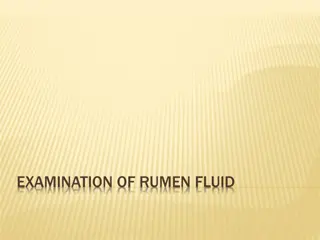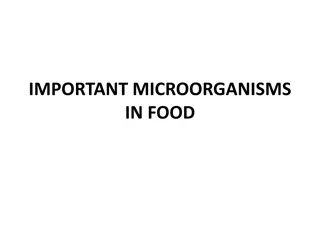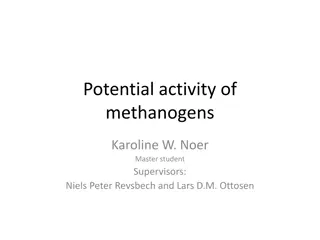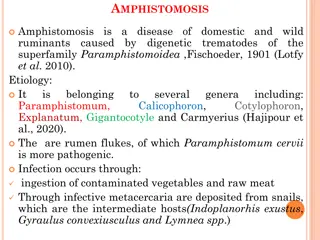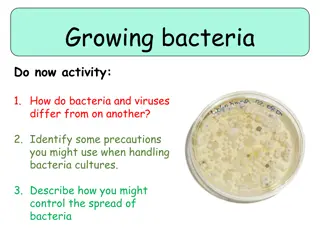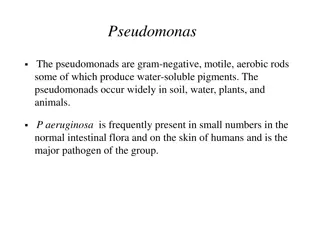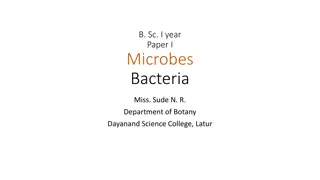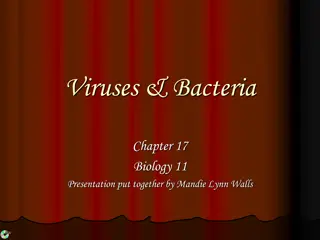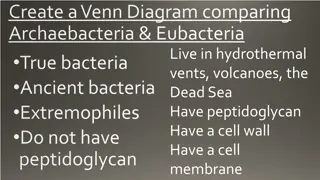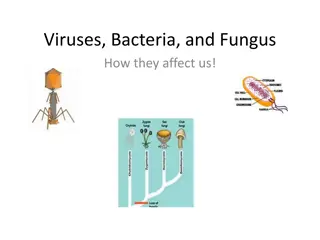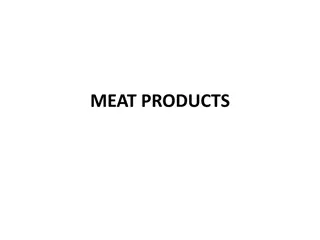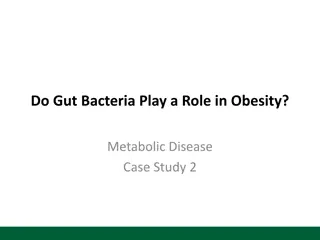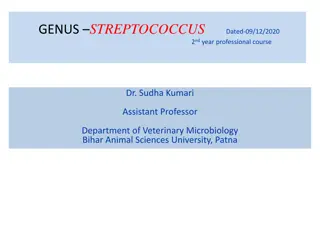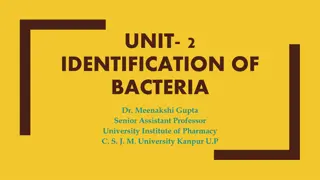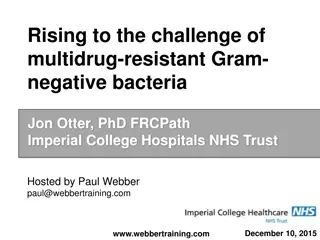Interactions Between Bacteria and Methanogens in the Rumen
The rumen, an anaerobic fermentation chamber in ruminant animals, houses a diverse microbial community including bacteria, fungi, protozoa, methanogenic archaea, and phages. Methanogens play a crucial role in methane production using fermentation end products. Research aims to explore evidence of interactions between bacteria and methanogens beyond traditional H2 or CO2 transfer, focusing on other ingredients. Methods involve rumen sampling and anaerobic media preparation.
Download Presentation

Please find below an Image/Link to download the presentation.
The content on the website is provided AS IS for your information and personal use only. It may not be sold, licensed, or shared on other websites without obtaining consent from the author. Download presentation by click this link. If you encounter any issues during the download, it is possible that the publisher has removed the file from their server.
E N D
Presentation Transcript
July 2014 Possible interactions between Bacteria and Methanogens residing the rumen Adi Israel Instructors: Itzhak Mizrahi PhD- The Agricultural Research Organization. Ronit Weisman PhD- The Open University. 1
The ruminant animal dependents on microorganisms residing in its upper digestive tract to digest and ferment plant cell-wall polysaccharides into absorbable energy sources such as short chain volatile fatty acids. The rumen is a pre-gastric anaerobic fermentation chamber at the upper digestive tract of the animal that houses mixed community of microorganisms The microbial community inhabiting the rumen is very diverse, containing bacteria, fungi, protozoa, methanogenic archaea and phages 2
The rumen is an anaerobic environment. In this environment organic matter is degraded by cooperative groups of anaerobic microorganism. Plant cell wall carbohydrates, proteins and other polymers of organic compounds originating from the animal feed are degraded into monomers. This degradation is carried out mostly by cellulolytic bacteria, fungi and protozoa operating as primary fermenters. These monomers are then fermented to CO2, H2 and volatile fatty acids (VFA s) such as acetate, propionate and butyrate by both the primary fermenters and secondary fermenters including microorganisms that are incapable of degrading complex polymers. Methanogens are the last link at this chain. They use the fermentation end products, mainly, H2 and CO2 to produce methane 3
In the rumen, the main procedure of methanogenesis is carried out by hydrogenotrophic methanogens which use CO2 as an electron acceptor and H2 as the electron donor. Hydrogenotrophic methanogens can also use formate instead of H2 as an electron donor. Methane production from formate is estimated at up to 18% from methane production in the rumen. There are others end products produced by the primary and secondary fermenters that methanogens use to produce methane from. Methylamines and methanol are used by methylotrophic methanogens. Recently this group of methanogens was found to be highly abundant in the rumen. The process by which one product is produced by one microbial species and consumed by another species is a typical example of syntrophic relationship. 4
project goal: Try to find an evidence for interactions between bacteria and methanogens residing the rumen that are not based on H2 or CO2 transfer but rather on transfer of other ingredients. 5
Materials and methods: Rumen sampling: Rumen fluid was sampled from ruminally fistulated Holstein cow. Medium preparation: anaerobic media containing the following ingredients: NaCl (1.02 g/l), KH2PO4 (0.51 g/l), (NH4)2SO4 (0.255 g/l), CaCl2 2H2O (0.134 g/l), MgSO4 7H2O (0.204 g/l), K2HPO4 3H2O (1.336g/l), yeast extract (2 g/l), 330 ml of depleted rumen fluid, 1 ml of resazurin 0.1%. Boiling cooling down under 100% CO2 gas add NaHCO3 (5 g/l) and cysteine-HCl (0.5 g/l) Before using this media ,a sterile mix of vitamin is added anaerobically (10 ml for 1L of media). Vitamin mix contains: 4-aminobenzoate (4 mg/l), D-(+)-biotin (1 mg/l), nicotinic acid (10mg/l), hemicalcium D-(+)- pantothenate (5 mg/l), pyridoxine hydrochloride (15 mg/l), thiamine hydrochloride (10 mg/l), cyanocobalamin (5 mg/l), D,L-6,8-thioctic acid (3 mg/l), riboflavin (3 mg/l) and folic acid (1 mg/l). 6
Dilutions: Rumen samples were diluted anaerobically according to this table: Amount of material from previous step Estimated count of methanogens/ml Number of tubes inoculated Dilution factor Medium volume Series name original sample Sample 1 10^9 4 ml of original sample 10^-1 10 36 ml 1 10^8 50ml tube 10^-2 10^-3 10^-4 10^-5 10^-6 10^-7 10^-8 10 1 ml 10 1 ml 10 1 ml 10 1 ml 10 1 ml 10 1 ml 10 1 ml 9 ml 9 ml 9 ml 9 ml 9 ml 9 ml 9 ml 1 10^7 1 10^6 1 10^5 1 10^4 1 10^3 1 1 1 1 1 1 1 100 10 1. Total 10 methanogens per tube 10^-9 10 1 ml 9 ml 1 2.5 methanogens per tube 2.5*10^-10 4 2.5 ml 7.5 ml 4 0.625 methanogens per tube 16 hungate tubes Iso_ 1-16 4 2.5 ml 7.5 ml 7
Study design: Original rumen sample Dilutions were made in order to get a culture which contains only one methanogen in it. Serial dilutions 16 final hungate tubes Methane production check by GC Tubes positive for methane production Additional growth for 14 days shaking in order to achieve homogeneous and stable cultures 8
homogeneous and stable culture transfer to fresh media (1:25 dilution) Addition of 3 antibiotics: ampicillin, erythromycin and vancomycin (all 50 g/ml) in order to reduce the amount of the bacteria. No addition of antibiotics 64h growth Methane measurement for all the tubes. 2ml culture sample taken from 1 tube from quadruplicate. DNA extraction. 16s rRNA gene deep-sequencing for Microbial community structure analysis. 9
Further analysis: 9 specific bacterial OTUs were chosen for further analysis based on the fact that most of them were present in all of the samples and based on their changes of their relative abundance according to the deep sequencing preformed previous Primer design Set of 2 primers (forward and reverse) was design manually based on the 150 bp sequence that was amplified in the deep-sequencing stage for these 9 chosen OTUs. Quantitative real time PCR Quantitative real-time PCR analysis was performed on the 9 bacterial OTUs described previously and on the methanogenic archaea, through amplification of their copy of the 16S rRNA gene. This allows examining the change of the methanogen amount and methane production according to the changes in the amount of the bacteria residing the culture with this methanogen. By that we can try finding an evidence for interaction between the methanogen and the bacteria 10
Results: Methane production: 5/16 tubes from one dilution set (iso-6) and 9/16 tubes from second dilution set (iso-8) were positive for methane production and were further grown. 4/5 from iso-6 and 3/9 from iso-8 were then tested for differences in methane emission and cell growth while supplemented with antibiotics as described before. Two of the cultures, iso6-3 and iso6-5 showed significantly different methane production as the culture that grew with the antibiotics produced more methane than the same culture without antibiotics (p<0.05). Methane production with and without antibiotics 100000 methane production (nmole) 10000 1000 average methane nmole no AB 100 Three of the cultures iso6-11, iso8-12 and iso8-13 showed the opposite pattern as the methane production with antibiotics was significantly higher without antibiotics (p<0.05) average methane nmole with AB 10 1 0.1 One culture, iso6-16, showed no significant difference in methane production. sample 11
Taxonomic assignment of methanogens and bacteria: Each sample contained 17 4 OTUs. One of these OTUs represents the methanogen in the sample while all the others represent the bacteria in the sample. Methanogens: Deep sequencing analysis revealed that iso6-3, iso6-15, iso6-16 contained each the same single methanogen belongs to the genus Methanobrevibacter. BLAST comparative analysis of partial 16S rRNA showed that it is close to M. gottschalkii specie (97% similarity). Iso8-12 and iso8-13 containeddifferent yet close single methanogens belong to the newly discovered family Methanomassiliicoccaceae according to Deep sequencing analysis. BLAST showed that Iso8-13 is close to Candidatus Methanogranum caenicola (93% similarity) from this family while iso8-12 is less similar to it (88% similarity). 12
Phylogenetic neighbor-joining tree was built using partial sequences of 16s rRNA gene of already known methanogens and the sequences of the methanogens in iso-6 and iso-8 cultures Phylogenetic neighbor-joining tree of methanogen archaea using partial sequences of 16s rRNA gene of already known methanogens and the sequences of the methanogens in iso-6 and iso-8 cultures. Bootstrap value displayed. 13
Bacteria: 9 specific bacterial OTUs were chosen for further analysis based on the fact that most of them were present in all of the samples and based on their changes of their relative abundance. These OTUs were identified by comparative analysis of partial 16S rRNA using BLAST Table 1: Taxonomic assignment of bacteria, with closest cultured relatives, identified by comparative analysis of 16S rRNA gene sequences. Sequence similarities were calculated from aligned gene sequences in BLAST. 14
Archaeal and bacterial abundance differences due to antibiotics treatment: In order to examine the changes in the actual amount of the methanogens and the bacteria due to the antibiotic treatment in the samples, quantitative real- time PCR was performed. Quantitative real-time PCR showed changes in archaeal and bacterial 16s count. Iso6 cultures results: The number of the methanogen in iso6-3, iso6-15 and iso6-6 cultures (M. gottschalkii like) was higher with the antibiotics treatment than without it while the numbers all of the bacteria that were examined decreased. 15
methanobrevibacter gottschalkaii methanogen like (- ab) methanobrevibacter gottschalkaii methanogen like (+ ab) Clostridium pasteurianum bacterium like (- ab) methanobrevibacter gottschalkaii methanogen like (- ab) methanobrevibacter gottschalkaii methanogen like (+ ab) Sporanaerobacter acetigenes (- AB) 100000000 100000000 1000000 16s copies number 1000000 16s copies number 10000 10000 100 100 1 1 iso6-3 iso6-15 iso6-16 sample iso6-3 iso6-15iso6-16 sample a b 1E+10 methanobrevibacter gottschalkaii methanogen like (- ab) methanobrevibacter gottschalkaii methanogen like (- ab) methanobrevibacter gottschalkaii methanogen like (+ ab) clostridium argentinense (-ab) 100000000 100000000 16s copies number 1000000 16s copies number 1000000 methanobrevibacter gottschalkaii methanogen like (+ ab) Bacillus thermoamylovorans (- ab) 10000 10000 100 100 1 clostridium argentinense (+ab) 1 iso6-3 iso6-15 iso6-16 sample iso6-3 iso6-15iso6-16 sample c d 16s copies number methanobrevibacter gottschalkaii methanogen like (- ab) methanobrevibacter gottschalkaii methanogen like (+ ab) Clostridium hastiforme (-ab) methanobrevibacter gottschalkaii methanogen like (- ab) methanobrevibacter gottschalkaii methanogen like (+ ab) Garciella nitratireducens bacterium like (-ab) Garciella nitratireducens bacterium like (+ab) 100000000 100000000 1000000 16s copies number 1000000 10000 10000 100 100 1 Clostridium hastiforme (+ab) 1 iso6-3 iso6-15 iso6-16 sample sample e f methanobrevibacter gottschalkaii methanogen like (- ab) methanobrevibacter gottschalkaii methanogen like (+ ab) Clostridium hastiforme bacterium like (-ab) Differences in the amounts of M.gottschalkaii like methanogen and the examined bacteria with (+ab) and without (-ab) antibiotics treatment in iso-6 cultures 100000000 1000000 16s copies number 10000 100 Clostridium hastiforme bacterium like (+ab) 1 16 iso6-3 iso6-15 iso6-16 sample g
Iso8 cultures results: Both of the methanogens in iso8-12 and iso8-13 reacted the same as their numbers were lower with the antibiotics treatment than without it Most of the bacteria that were examined in iso8-12 and 13 showed lower numbers with the antibiotics treatment , except clostridium hastiforme and clostidium hastiforme like bacterium that were higher with the antibiotics treatment only in iso8-13 culture, and Clostridium aminovalericumthat that was higher with antibiotics treatment both in iso8-12 and iso8-13 cultures. 17
1E+09 methanogen from Methanomassiliicocca ceae family (-ab) methanogen from Methanomassiliicoccacea e family (-ab) 1E+09 16s copies number 16s copies number 1000000 1000000 methanogen from Methanomassiliicocca ceae family (+ab) methanogen from Methanomassiliicoccacea e family (+ab) 1000 1000 1 1 Clostridium pasteurianum bacterium like (- ab) Thermoanaerobacteracea e bacterium like (-ab) iso8-12 iso8-13 iso8-12 iso8-13 sample sample a b 1E+10 methanogen from Methanomassiliicocc aceae family (-ab) methanogen from Methanomassiliicoc caceae family (-ab) 100000000 100000000 16s copies number 16s copies number 1000000 1000000 methanogen from Methanomassiliicocc aceae family (+ab) methanogen from Methanomassiliicoc caceae family (+ab) 10000 10000 100 100 Clostridium aminovalericum (-ab) Garciella nitratireducens bacterium like (-ab) 1 1 iso8-12 iso8-13 iso8-12 iso8-13 c d sample sample methanogen from Methanomassiliicocc aceae family (-ab) methanogen from Methanomassiliicocc aceae family (+ab) Bacillus thermoamylovorans (-ab) Bacillus thermoamylovorans (+ab) 1E+09 1E+09 methanogen from Methanomassiliicoccace ae family (-ab) 16s copies number 16s copies number 1000000 1000000 methanogen from Methanomassiliicoccace ae family (+ab) 1000 1000 1 1 Clostridium hastiforme (- ab) iso8-12 iso8-13 iso8-12 iso8-13 sample sample f e 1E+09 methanogen from Methanomassiliicocc aceae family (-ab) methanogen from Methanomassiliicocc aceae family (+ab) Clostridium hastiforme bacterium like (-ab) Differences in the amounts of methanogen and the examined bacteria with (+ab) and without (-ab) antibiotics treatment in iso- 8 cultures 1000000 16s copies number 1000 1 iso8-12 iso8-13 sample g 18
In order to summarize the relation between the methanogen and the examined bacteria which are present in its culture, a table was built. Table 2: summarize of the relation between the methanogen amount change and the examined bacteria amount changes based on 16s rRNA gene copies count by qPCR. (-) colored in red represents inverse relation meaning when one increases the other decreases. (+) colored in green represents direct relation meaning when one decreases the other decreases also. N/A- not detected in the sample. We can see that regarding the methanogen of iso-6 cultures, M. gottschalkii methanogen like, most of the examined bacteria are negative correlated with this methanogen Regarding the methanogen in iso8-12 culture, most of the examined bacteria are positive correlated with it except Clostridium aminovalericum which is negative correlated. This bacterium is also negative correlated with the methanogen in iso8-13 culture. Both of the clostridium hastiforme bacteria are negative correlated with the methanogen in iso8-13 culture. 19
Discussion: Negative interaction such as competition can exist between one or more of the examined bacteria and the methanogen from iso-6 cultures. This methanogen belongs to the methanobrevibacter genus which most of its members use CO2 and H2 to form CH4. These bacteria and methanogen can compete each other on other vital ingredients in the media such as vitamins, essentials amino acids, nitrogen source, trace elements and other unknown vital ingredients in the rumen fluid. Negative correlation can also be due to the presence of the bacterium Sporanaerobacter acetigenes. This is a strictly anaerobic bacterium which facultatively uses elemental sulfur as a terminal electron acceptor, producing sulfide. Sulfide is a known methanogenesis inhibitor (sulfide and sulfate inhibition of methanogenesis) as it converts to hydrogen sulfide (H2S) which is toxic to methanogens. Therefore the assumption is that when this bacterium is reduced, H2S formation is reduces also and methanogenesis can take place. 20
More interesting is the positive correlation between iso8-12 and iso8-13 methanogens and some of the examined bacteria. The assumption is that the antibiotics did not affect the methanogen directly because methanogens are not sensitive to these antibiotics types and concentration The iso8 methanogens belongs to the family Methanomassiliicoccaceae which its so far known members use methyl compounds with or without H2 to form methane and do not use CO2 and called methylotrophic methanogens. Recent study showed that this group of methanogens in the rumen called RCC (rumen cluster C) uses methylamines (MA s) as their major energy and carbon source. Most of the examined bacteria belong to the order clostridiales. Several studies showed that some members of this group form methylamines in the rumen We can assume that one or more of the examined bacteria produce methylamine or other methyl compounds which the methanogen use as an energy and carbon source to form methane With the reduction of the bacteria amount we can assume that less methyl compounds are produced and the methanogens have less energy and carbon source to use. 21


